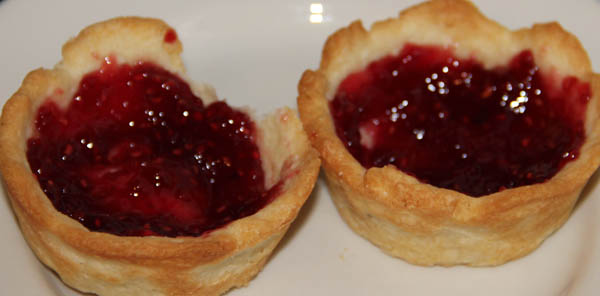Queen of Tarts
September 8th, 2011
I guess I do make a lot of tart shells. This week alone, I’ve baked nine batches, a grand total of 204 shells. Don’t laugh, there were extenuating circumstances. And I only kept one set for myself. We’re still eating them — three of the dozen were filled with cheese and glazed onions. The rest have been slowly but surely spread with raspberry jam and eaten for elevenses (I can’t seem to get through a morning at work without a cuppa and a nibble) or for dessert.

Here’s tonight’s ration. I took mine with a mango black tea latte. He had his with a mug of China green tips. After these, there are just two more.
I can’t tell you how thrilled I was when someone asked for my tart shell receipt yesterday. So here it is, in all it’s glaring modernity.
Not-19th-Century Tart Shells
Makes 24 mini shells, or 12 standard-cupcake size shells.1 cup flour
1 stick butter
3 oz cream cheeseBring butter and cream cheese to room temperature — they will be very soft. Blend butter and cream cheese with a fork or a mixer. Whip a few seconds, until very smooth. Sift in the flour and mix with a fork or pastry blender. Form a ball of dough as soon as you can, adding a little flour if needed. The less you work the dough, the more tender the result!
Wrap the ball of dough in a plastic bag and let it rest in the refrigerator for at least an hour, or up to 24. Cut in half, and in half again. If you’re making mini shells, cut each piece once more in half, for a total of 8. Pull each of the four, or eight, pieces of dough into three parts. Put the little balls of dough into an ungreased muffin tin. Using your finger, spread the dough to cover the bottom and sides of each muffin. You may need to let the dough warm up a little to make it easier to spread.
Prick the bottom of each shell with a fork. Bake at about 400 degrees for 10-15 minutes, or until the edges are golden brown.
This is a totally modern recipe. I found it on the internet a few years ago, shortly after I began catering tea parties. It is fail-safe, quick, and easy. Also, it produces a tender, rich, flaky crust. Butter alone is harder to manage, and always seems a little tough. My Gram, whose pie crusts are legendary for their blue-blooded delicacy, taught me to use Crisco. But after the whole hydrogenation scandal, I’ve tried to avoid it.
How did they manage in the 19th century, you ask? Surely they didn’t just endure tough “paste” (Victorian for pie crust) until the advent of Crisco? They used lard. Which I’ve never tried because it too is now hydrogenated, at least the kind they sell in my local market.
